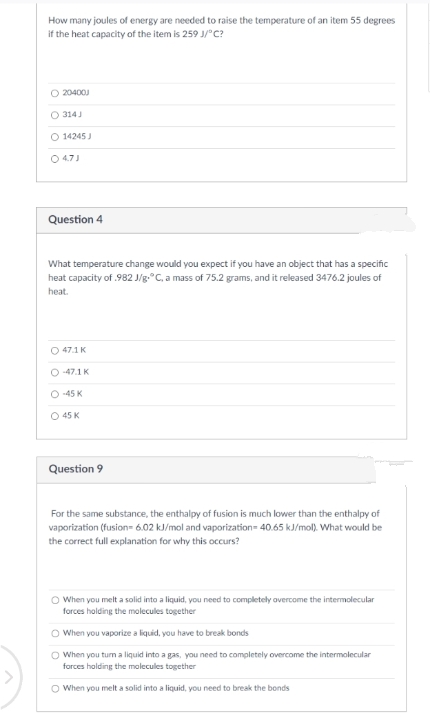How many joules of energy are needed to raise the temperature of an item 55 degrees if the heat capacity of the item is 259 J/"C? O 20400J O 314J O 14245 J O 4.71
How many joules of energy are needed to raise the temperature of an item 55 degrees if the heat capacity of the item is 259 J/"C? O 20400J O 314J O 14245 J O 4.71
Chemistry for Engineering Students
4th Edition
ISBN:9781337398909
Author:Lawrence S. Brown, Tom Holme
Publisher:Lawrence S. Brown, Tom Holme
Chapter9: Energy And Chemistry
Section: Chapter Questions
Problem 9.104PAE: 9.104 An engineer is using sodium metal as a cooling agent in a design because it has useful thermal...
Related questions
Question

Transcribed Image Text:How many joules of energy are needed to raise the temperature of an item 55 degrees
if the heat capacity of the item is 259 J/"C?
O 20400J
O 314J
O 14245 J
O 4.7J
Question 4
What temperature change would you expect if you have an object that has a specific
heat capacity of 982 J/g.°C, a mass of 75.2 grams, and it released 3476.2 joules of
heat.
O 47.1 K
O 47.1 K
O -45 K
O 45 K
Question 9
For the same substance, the enthalpy of fusion is much lower than the enthalpy of
vaporization (fusion= 6.02 kJ/mol and vaporization= 40.65 kJ/mol). What would be
the correct full explanation for why this occurs?
O When you melt a solid into a liquid, you need to completely overcome the intermolecular
forces holding the molecules together
O When you vaporize a liquid, you have to break bonds
O When you turm a liquid into a gas, you need to completely overcome the intermolecular
forces holding the molecules together
O When you melt a solid into a liquid, you need to break the bonds
Expert Solution
This question has been solved!
Explore an expertly crafted, step-by-step solution for a thorough understanding of key concepts.
This is a popular solution!
Trending now
This is a popular solution!
Step by step
Solved in 2 steps with 2 images

Knowledge Booster
Learn more about
Need a deep-dive on the concept behind this application? Look no further. Learn more about this topic, chemistry and related others by exploring similar questions and additional content below.Recommended textbooks for you

Chemistry for Engineering Students
Chemistry
ISBN:
9781337398909
Author:
Lawrence S. Brown, Tom Holme
Publisher:
Cengage Learning

Chemistry: The Molecular Science
Chemistry
ISBN:
9781285199047
Author:
John W. Moore, Conrad L. Stanitski
Publisher:
Cengage Learning

Introductory Chemistry: A Foundation
Chemistry
ISBN:
9781337399425
Author:
Steven S. Zumdahl, Donald J. DeCoste
Publisher:
Cengage Learning

Chemistry for Engineering Students
Chemistry
ISBN:
9781337398909
Author:
Lawrence S. Brown, Tom Holme
Publisher:
Cengage Learning

Chemistry: The Molecular Science
Chemistry
ISBN:
9781285199047
Author:
John W. Moore, Conrad L. Stanitski
Publisher:
Cengage Learning

Introductory Chemistry: A Foundation
Chemistry
ISBN:
9781337399425
Author:
Steven S. Zumdahl, Donald J. DeCoste
Publisher:
Cengage Learning

Chemistry: Principles and Reactions
Chemistry
ISBN:
9781305079373
Author:
William L. Masterton, Cecile N. Hurley
Publisher:
Cengage Learning

Chemistry: An Atoms First Approach
Chemistry
ISBN:
9781305079243
Author:
Steven S. Zumdahl, Susan A. Zumdahl
Publisher:
Cengage Learning

Chemistry by OpenStax (2015-05-04)
Chemistry
ISBN:
9781938168390
Author:
Klaus Theopold, Richard H Langley, Paul Flowers, William R. Robinson, Mark Blaser
Publisher:
OpenStax